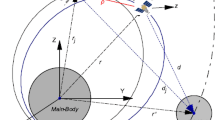Abstract
A space station in the vicinity of the Moon can be exploited as a gateway for future human and robotic exploration of the solar system. The natural location for a space system of this kind is about one of the Earth–Moon libration points. The study addresses the dynamics during rendezvous and docking operations with a very large space infrastructure in an EML2 Halo orbit. The model takes into account the coupling effects between the orbital and the attitude motion in a circular restricted three-body problem environment. The flexibility of the system is included, and the interaction between the modes of the structure and those related with the orbital motion is investigated. A lumped parameter technique is used to represents the flexible dynamics. The parameters of the space station are maintained as generic as possible, in a way to delineate a global scenario of the mission. However, the developed model can be tuned and updated according to the information that will be available in the future, when the whole system will be defined with a higher level of precision.

















Similar content being viewed by others
References
ISECG: The global exploration roadmap (2013)
Guzzetti, D., Armellin, R., Lavagna, M.: Coupling attitude and orbital motion of extended bodies in the restricted circular 3-body problem: a novel study on effects and possible exploitations (2012)
Knutson, A.J., Guzzetti, D., Howell, K.C., Lavagna, M.: Attitude responses in coupled orbit-attitude dynamical model in earth-moon lyapunov orbits. J. Guid. Control Dyn. 38(7), 1264–1273 (2015)
Colagrossi, A., Lavagna, M.: Preliminary results on the dynamics of large and flexible space structures in Halo orbits. Acta Astronaut. 134, 355–367 (2017)
Shabana, A.A.: Dynamics of multibody systems. Cambridge University Press, Cambridge (2013)
Kane, T.R., Likins, P.W., Levinson, D.A.: Spacecraft Dynamics. McGraw-Hill Book Co., New York (1983)
Peláez, J., Sanjurjo, M., Lucas, F., Lara, M., Lorenzini, E., Curreli, D., Scheeres, D., Bombardelli, C., Dario, I.: Dynamics and stability of tethered satellites at lagrangian points. ESA ACT Report (2008)
Flores, P.: Euler angles, bryant angles and euler parameters. In: Concepts and Formulations for Spatial Multibody Dynamics. Springer, New York, pp. 15–22 (2015)
Meirovitch, L.: Fundamentals of vibrations. Waveland Press, Long Grove (2010)
Junkins, J.L.: Introduction to Dynamics and Control of Flexible Structures. AIAA Education Series, Reston (1993)
Fehse, W.: Automated rendezvous and docking of spacecraft, vol. 16. Cambridge university press, Cambridge (2003)
Lizy-Destrez, S.: Rendez vous optimization with an inhabited space station at EML2. In: Proceedings of the 25th International Symposium on Space Flight Dynamics (ISSFD). Munich (2015)
Murakami, N., Ueda, S., Ikenaga, T., Maeda, M., Yamamoto, T., Ikeda, H.: Practical rendezvous scenario for transportation missions to cis-lunar station in Earth–Moon L2 Halo orbit. In: Proceedings of the 25th International Symposium on Space Flight Dynamics (ISSFD). Munich (2015)
Ueda, S., Murakami, N.: Optimum guidance strategy for rendezvous mission in earth-moon l2 halo orbit. In: Proceedings of the 25th International Symposium on Space Flight Dynamics (ISSFD). Munich (2015)
Bernelli, F., Topputo, F., Massari, M.: Assessment of mission design including utilization of libration points and weak stability boundaries. ESA ACT Report (2004)
Koon, W.S., Lo, M.W., Marsden, J.E., Ross, S.D.: Dynamical systems, the three-body problem and space mission design. Marsden Books, Wellington (2008)
Pavlak, T.A.: Trajectory design and orbit maintenance strategies in multi-body dynamical regimes. Ph.D Dissertation (2013)
Byrd, R.H., Gilbert, J.C., Nocedal, J.: A trust region method based on interior point techniques for nonlinear programming. Math. Program. 89(1), 149–185 (2000)
Waltz, R.A., Morales, J.L., Nocedal, J., Orban, D.: An interior algorithm for nonlinear optimization that combines line search and trust region steps. Math. Program. 107(3), 391–408 (2006)
Nocedal, J., Wright, S.: Numerical optimization. Springer Science & Business Media, New York (2006)
Farquhar, R.W.: The control and use of libration-point satellites (1970)
Author information
Authors and Affiliations
Corresponding author
Additional information
This paper is based on a presentation at the 6th International Conference on Astrodynamics Tools and Techniques, March 14–17, 2016, Darmstadt, Germany.
Rights and permissions
About this article
Cite this article
Colagrossi, A., Lavagna, M. Dynamical analysis of rendezvous and docking with very large space infrastructures in non-Keplerian orbits. CEAS Space J 10, 87–99 (2018). https://doi.org/10.1007/s12567-017-0174-4
Received:
Accepted:
Published:
Issue Date:
DOI: https://doi.org/10.1007/s12567-017-0174-4




